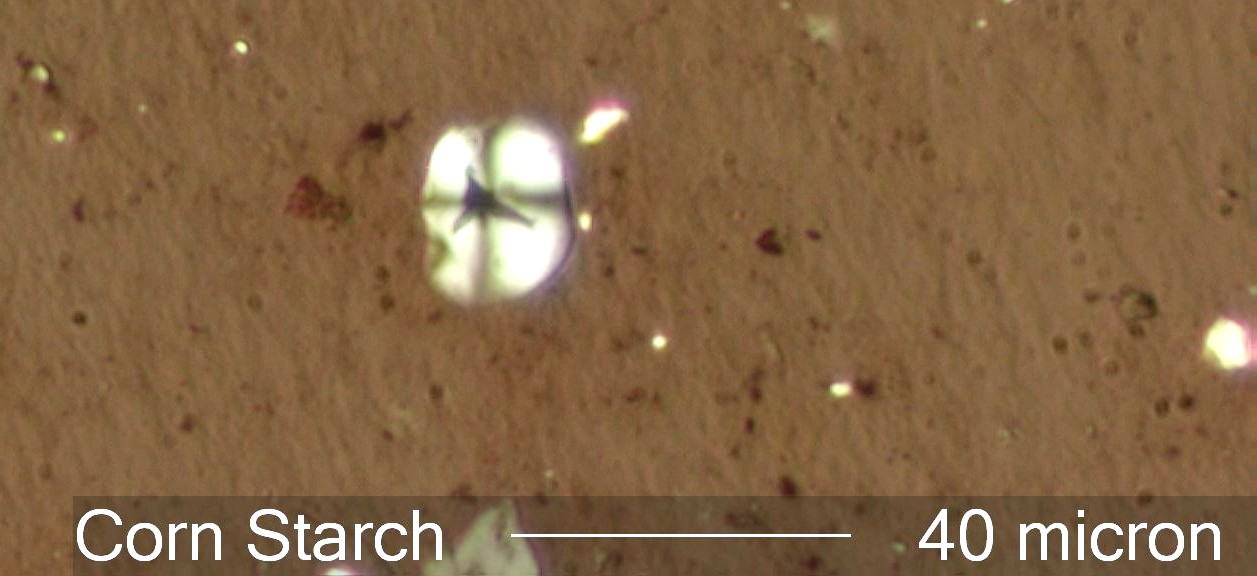Corn Starch
This particle is from an oil sample collected from a 8400kVA transformer. The bright particle in the center of this image is corn starch. Corn starch is ubiquitous. It is extensively used as a mold release agent, a filler in plastics and other construction materials, a carrier for pharmaceuticals and fragrances,a component of cosmetics and hand lotions, and as a foodstuff. Corn starch is characterized by the trilete scar at the center of the grain, the cross pattern when viewed with crossed linear polarized light (characteristic of all starches), and its polyhedral outline.
Transmitted Oblique Off Crossed Polarized Light
Starch grains are are a means for plants to store energy. They are produced by a wide variety of plants and are a mixture of alpha-amylose and amylopectin. Starch grain differ in their size, their shape, and the structure of the center vacuole. Many of these differences are useful for the identification of the plant of origin for the starch grain.
Martin, E.A., Dictionary of Life Sciences, 2nd ed., Pica Press
Brady, George S. and Henry R. Clauser (eds), MATERIALS HANDBOOK, 11th Edition, McGraw-Hill, pp.748-752, 1979
Definition/Function:
Corn starch is derived from Zea mays. it is by far the most common starch grain encountered in the indoor environment. It is used in paper sizing, coating plastics, coating candy, as a body powder, as a carrier for fragrances and pesticides, as an extender coatings and paints, a mold-release in formed polymer manufacture, and many other uses.Starch grains are are a means for plants to store energy. They are produced by a wide variety of plants and are a mixture of alpha-amylose and amylopectin. Starch grain differ in their size, their shape, and the structure of the center vacuole. Many of these differences are useful for the identification of the plant of origin for the starch grain.
Significance in the Environment:
Starch is common in the indoor environment. It is widely used as a body powder, a carrier for fragrances, for insecticides, for mold-release, and many other applications. Surgical gloves must be free of rice starch because rice starch inside the body cavity can cause infection. Corn starch in the same body cavity has no effect.Characteristic Features:
Corn starch tends to be polyhedral to subspherical in shape and generally 10 to 20 micrometers in diameter. The center vacuole may be spherical but is generally an elongated scar with pointed ends. It may have from 2 to 5 points forming a slit or star-like structure.Associated Particles:
If corn starch is found with significant amounts of dog dander it may indicate the presence of an insecticide. People in the locality should be questioned about the use of flea powders or powdered fresheners. When used as a body powder it is often associated with other cosmetic particles. When it is a food residue then other food particles are generally present and some cooked starch may be associated with the particles. When it is from a manufacturing process there are generally other residues from that process present. When it is from paper sizing there are generally ink or toner particles and significant amounts of paper fiber present.References:
http://en.wikipedia.org/wiki/StarchMartin, E.A., Dictionary of Life Sciences, 2nd ed., Pica Press
Brady, George S. and Henry R. Clauser (eds), MATERIALS HANDBOOK, 11th Edition, McGraw-Hill, pp.748-752, 1979


